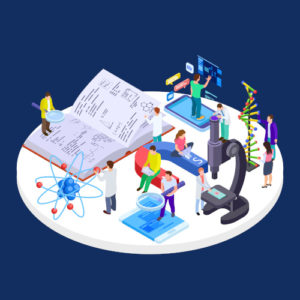As more students than ever before face taking science courses to supplement their chosen major in higher education, many are still struggling through laboratory-based coursework due to a simple lack of accessibility and personalization options to meet their individual needs. From forensics and graphic design to even prosthetic makeup for film majors, modern programs of study are increasingly including science course requirements, making STEM an integral component of a future-founding curriculum.
A student-centered educational approach incorporating supportive tools and digital solutions that address learner access can create comfortable experiences with tricky topics and promote positive outcomes for all.
The laboratory has come to be an auspicious space, imbued with the success of the most significant innovations and discoveries in human history, including DNA’s structure, photosynthesis, the germ theory of disease, and the unfolding story of our galaxy’s birth. Whether creating a better polymer for Hollywood monster makeup or developing vaccines for the global COVID-19 pandemic with unprecedented speed, the number of career tracks that benefit from scientific and laboratory expertise has expanded rapidly.
Creating access to such valuable training places huge additional stress on already-stretched departments and highlights the need for increased support for diverse learners. How do we expand the opportunities for student success in STEM-related courses to meet modern demands?
Online science labs
There are wet lab training elements that virtual learning cannot yet replace entirely, however, the goal for virtual learning experiences should never be to build a lab replacement. Instead, digital simulated environments, including those with a laboratory setting, should be used to provide a coherent, intuitive and feedback-rich resource that scaffolds a broad curriculum of traditional and innovative teaching practices.
While developing and honing manual dexterity can only be progressed through physical practice, students lacking exposure to scientific protocols or who harbor anxieties around entering the laboratory space can derive cognitive benefits from virtual lab experiences. These digital resources offer a low-pressure environment where students can prepare for procedural and safety training that sits at the foundation of confident and professional laboratory practice.
For students who are completely new or returning to scientific training after a break, virtual labs create an opportunity to try out lab techniques for the first time. Indeed, in cases where equipment is expensive, or where already limited access is reserved for students in core STEM programs, a virtual lab might represent the only experience a student has with a particular piece of kit. With time-on-tech at a premium, students can become familiar with equipment that they have only a small window of opportunity to engage with. As an undergrad at Newcastle University, I remember we had access to the solitary gas chromatography instrument that served the entire university. My lecturer had a hard time scheduling meaningful experiences for me and all 50 of my pharmacology coursemates with that tech. Remote and virtual learning methods could have helped us make the most of the limited time we had to engage by building fluency and competence with safety and operating procedures ahead of time.
As more institutions recognize value in supplementing degree curricula with science courses, access and training demand challenges are exacerbated by an urgent lack of resources and physical space. Virtual learning solutions can help solve this problem without the need to increase infrastructure budgets to build more labs or purchase additional instrumentation that will go otherwise unused for huge stretches of the academic year.
Transforming education with technology
The goal of developing virtual learning experiences should be to create equitable access for every user by embedding quality learning opportunities and challenges within each simulation. Developing features that solve for in-person pain points of labs, like a screen reader and voiceover functionality for sight-impacted users, will truly evolve what’s possible of gamified pedagogical paradigms to continue smashing barriers to engagement that have traditionally marginalized some students within educational establishments. I’m confident the trend of integrating science training with increasingly diverse degree programs will continue, and the need to constantly innovate and iterate on our approach to access provision will become standard practice. No-one with a desire to engage with STEM learning should be dismissed.
The COVID-19 pandemic split opinion on the values of online learning. Some students experienced a ‘Fauci Effect’ and were inspired to begin studying science online. Like so many of us now navigating the balance between remote and in-person working, educators are concluding that the path forward follows a hybrid model. The solution for expanding STEM access is not replacing tried and tested wet lab experiences. Instead, we should strive to transform learning by creating space for technologies that bring something unique and new to the curriculum. Simulated environments, like virtual labs, create an opportunity that otherwise cannot be met with the time, space, and resources of a traditional institution while truly scaffolding the goals and objectives of a program and creating equitable access for all learners.
Virtual learning has proven to be a powerful tool in the quest to better serve all learners, including those with physical, economic, or geographic challenges who could have previously found themselves marginalized within their chosen field of study. Technological innovation will remain of paramount importance as we navigate the global challenges already making themselves urgently felt. We need the contribution of every scientist we can possibly train to solve the problems that lie before us all. We simply must ensure that high-quality, equitable access to experiential STEM learning becomes the standard and not the exception.
New technologies can help bridge the gaps between in-person and virtual student successes. I see so much potential revolution surrounding how we choose to educate the next generation of scientists. If we listen to teachers and students, we can create a future of education that is welcoming and comfortable for all.
- A bungled FAFSA rollout threatens students’ college ambitions - April 19, 2024
- Using real-world tools to prepare students for the workforce - April 18, 2024
- 8 top trends in higher education to watch in 2024 - April 16, 2024

